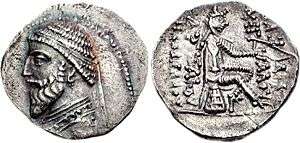Artabanus II of Parthia

- For another ruler also known as Artabanus I, see Arsaces II of Parthia.
Artabanus II of Parthia (Persian: اردوان دوم) ruled the Parthian Empire from c. 126 to 122 BC.[1] The son of Phriapatius, it was originally believed that he succeeded his nephew Phraates II in 126 BC; however, new evidence suggests that he succeeded his brother Bacasis, who reigned briefly in 126 BC.[2] Just like Phraates II, Artabanus died in battle against the nomads in the East, namely the Tochari (a name commonly identified with the Yuezhi of the Chinese sources)[3] who had apparently invaded the eastern territories of Iran:
- "Bello Tochariis inlato, in bracchio vulneratus statim decedit"
- "During the war against the Tokharians, he was wounded in the arm and died immediately" Justin, Epitomes, XLII,2,2.
He is perhaps identical with the Artabanus mentioned in Trogus, Prologi, xli, 5.
Cuneiform and numismatic evidence also suggests that his young son, Arsaces X, succeeded him and reigned for a year (122-121 BC), after which Mithridates II became king.[4]
References
 This article incorporates text from a publication now in the public domain: Chisholm, Hugh, ed. (1911). "Artabanus". Encyclopædia Britannica (11th ed.). Cambridge University Press.
This article incorporates text from a publication now in the public domain: Chisholm, Hugh, ed. (1911). "Artabanus". Encyclopædia Britannica (11th ed.). Cambridge University Press.- Justin, Epitome of Pompeius Trogus, xli, 2
| Artabanus II of Parthia Died: 122 BC | ||
| Preceded by Phraates II |
Great King (Shah) of Parthia 126–122 BC |
Succeeded by Mithridates II |